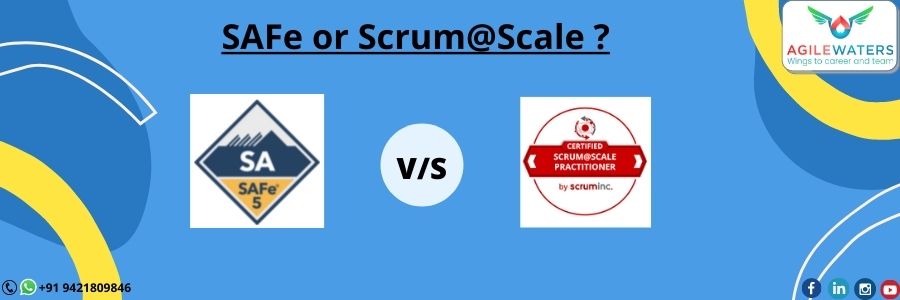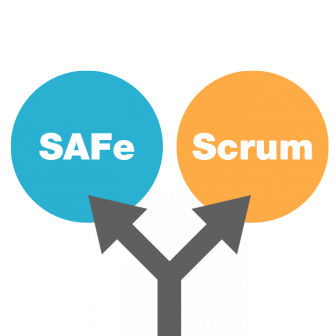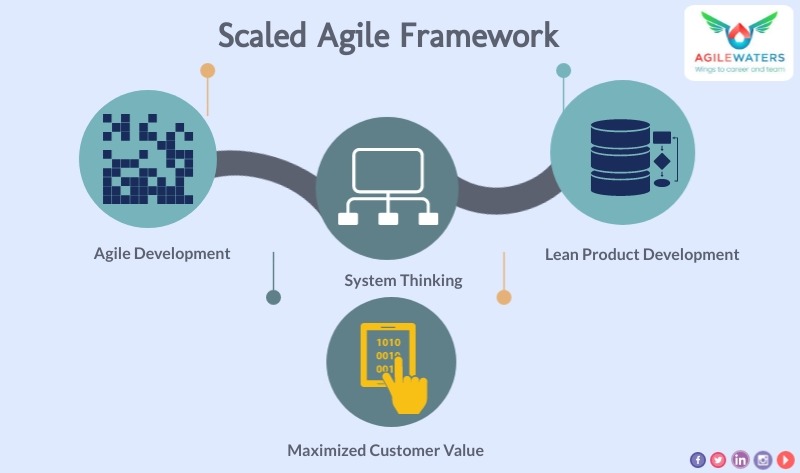
When comparing scaling Agile frameworks like SAFe® (the Scaled Agile Framework), Scrum@Scale, Disciplined Agile Delivery (DAD), or LeSS (Large-Scale Scrum). The question isn’t which framework is best for you, but which framework is best for you. You can choose which scaling framework to utilize by considering your specific environment, methods, and goals.
SAFe and Scrum at Scale: What’s the Difference?

All of the ten or so different frameworks for scaling Agile technique are based on Scrum in some way (including, of course, Scrum at Scale and SAFe). Only one framework, however, is designed for, mature enough for, and adequately documented for usage in large enterprises.
The Scaled Agile Framework is a framework for scaling up agile projects (SAFe)
By far the most popular framework for scaling Scrum in large enterprises is the Scaled Agile Framework (SAFe). It’s also worth noting that SAFe is built to support DevOps, a strategy that’s becoming increasingly vital for future-proofing Agile businesses.
SAFe is an approach that defines a highly organized framework for implementing and operating an Agile value stream in an organizational context. It’s appropriate for large firms that want to keep as much organizational and process structure.
Because SAFe isn’t as adaptable as Scrum at Scale, an in-depth review of your value creation processes is required before planning an Agile shift utilizing this framework.

Scrum Scaling with SAFe®
The Scaled Agile Framework, or SAFe for short, is a lean and agile framework that aids in expanding Scrum to the enterprise. To ensure enterprise success, it aids in the management of alignment, collaboration, and delivery from various agile teams. To maximize value and ensure a successful agile transition. It methodically focuses on deploying Scrum at each level of the company.
SAFe adoption results in considerable gains in strategy, delivery, execution, and business capabilities, as well as end-to-end business agility. It aids businesses in overcoming the competition and ensuring innovative business solutions in order to acquire customer trust and collaboration.
Scrum@Scale
Dr. Jeff Sutherland and Alex Brown’s Scrum at Scale is the most recent of all the Agile scaling frameworks, having been officially unveiled at Agile 2014 in Orlando. When compared to SAFe, it is thus less well-tested and documented, making it less suitable for large-scale adoption. It’s a modular way to scale the well-known Scrum framework, in a nutshell.
Scrum@Scale is a scaled-down version of the Scrum framework. This basically means that wherever Scrum is used, Scrum at Scale can assist in scaling the framework. As a result, it is a perfect solution for businesses of all sizes in theory.
It employs a modular approach to expanding Scrum. The purpose of align the entire organization around a common set of objectives. The primary argument in favor of a modular approach to expanding Scrum is that no two Scrum implementations are the same.
Scrum@Scale is a framework for scaling Scrum.
The Scrum@Scale framework is another framework that enables enterprises to apply Scrum at scale. This framework builds on Scrum’s key ideas and aids in scaling Scrum across a wide range of businesses and sectors, assuring customer satisfaction and successful product development. It encourages collaboration across all teams and departments, maximizes resources, eliminates obstacles, and ensures the development of creative goods.
Which framework is most suited to your needs?
There is no silver bullet answer for all development difficulties, as there isn’t in the Agile industry. Which scaling framework is suitable for your organization depends on its characteristics, goals, environment, and Agile competence.
SAFe is considered overly inflexible by some. Since it is built on a top-down approach and provides numerous layers, roles, events, and artifacts to maintain the organizational structure that businesses are accustomed to. This adds complexity and limits SAFe’s ability to adapt to a specific environment as easily as other frameworks.
Scrum@Scale, on the other hand, is a more adaptable option for teams working with highly customized procedures or in unconventional settings. This framework is based on the scrum-of-scrums concept, which ensures scalability while remaining true to Scrum’s core. While the flexibility it provides is enticing, principles like Minimum Viable Bureaucracy make it less suitable for teams working on a mission- or safety-critical products that require extensive documentation to ensure audibility.
Tooling that can be scaled
The question of agile tooling is still up for debate. While the Agile methodology emphasizes the significance of “individuals and interactions over processes and tools,” most experts agree that proper tooling is critical, particularly in a scaled context. When several teams collaborate on complicated projects, alignment, transparency, and collaboration are challenging to achieve; therefore, sufficient digital tooling for collaborative development is essential.
Tools that help teams adopt and scale Scrum or any other Agile process can have a big impact on their profitability, efficiency, and satisfaction.
A Final Thought
Companies may reap all of the benefits of team-level Scrum at scale by driving Agile at the organizational level. The principles of Scrum at the team level are frequently not sustainable at the corporate level, and the transformation fails. Agile scaling frameworks that have been tested and proved. Now assist organizations to scale up Scrum’s concepts and practices to become more adaptable, agile, and responsive. Professionals may grasp these frameworks and assist their organizations in adopting the Scrum and agile culture, mindset, and principles.








